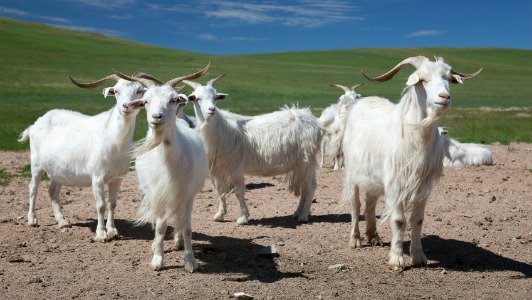What is Cashmere?

Source: http://www.mongolia-travel-guide.com/
What is cashmere?
The term ‘cashmere’ relates to any fabric constructed with cashmere yarn or fibre. It is a super-soft and luxurious form of wool harvested from the underbellies of cashmere goats, and is classed as a speciality hair fibre.
What’s the difference between cashmere and pashmina?
It’s a common misconception that cashmere is purer than pashmina wool. In actual fact, there is no difference between the two. Generally, it is simply a case of dialects and regional preferences towards the name of the product. In Europe, it is mostly referred to as cashmere, whereas in parts of Asia, it is mostly known as pashmina.
Pashmina can also refer to one of the methods in which cashmere is used; pashmina is often used for scarves and shawls, as it is very fine and soft.
Where does cashmere come from?
Our cashmere begins its journey in the very high-altitude areas of Mongolia. The cashmere goats grow a full, thick coat of wool on their underbellies to keep them warm in the icy temperatures.
How is cashmere made?
There are five fundamental steps to cashmere production.
During the molting season in the springtime, the herders collect the cashmere fibres by combing the goat. They then separate the soft, fine cashmere fibre from the goat’s coarse hair on top by hand. The cashmere is then scoured and washed to remove any grease, dirt or vegetable matter which could have been collected in the combing process, before being dehaired to remove dandruff and any remaining coarse outer hair.
The cashmere is then ready to be sent to factories to be spun into yarn for knitting and weaving, and eventually carefully crafted into cashmere scarves or jumpers.
Why is cashmere so expensive?
The labour involved in maintaining the highest quality cashmere is an extensive task. Herders must separate the soft cashmere on the underbellies of the goats from the coarse wool on top all season, usually individually, and all by hand.
When it comes to harvesting, one goat usually provides around 450-500g of cashmere per year, meaning you’d need two goats to produce one two-ply cashmere jumper annually.
Due to this, there is a low production rate of pure cashmere. Typically, only 6,500 metric tons of pure, authentic cashmere is produced annually, compared to 2 million metric tons of sheep’s wool.
As you can imagine, cashmere has become a popular material to imitate as well as exaggerate in modern markets. To keep you away from faux cashmere products, we’ve compiled a helpful list of tips, so you know what to look out for. (link: )
Why buy cashmere products from Lovarzi?
Here at Lovarzi, providing you with top quality products is our priority.
We chose our manufacturers after carefully examining how they sourced and produced their cashmere. All their cashmere is bought directly from the nomads in Tibet and Mongolia, meaning it’s not adulterated in any way. A fair price is paid for it, so you can be assured that it’s sourced ethically.
We want to provide you with the softest, most authentic cashmere as possible. Our products are beautifully crafted without being altered, meaning you’re getting the absolute best for your hard-earned money.
We’ve spent a lot of time researching our cashmere, as well as visiting various people from all over the world to gain the most accurate insight into it. If you’ve got any further questions on where our cashmere comes from, please drop us email at enquiry@lovarzi.co.uk or call us on 08456529519
